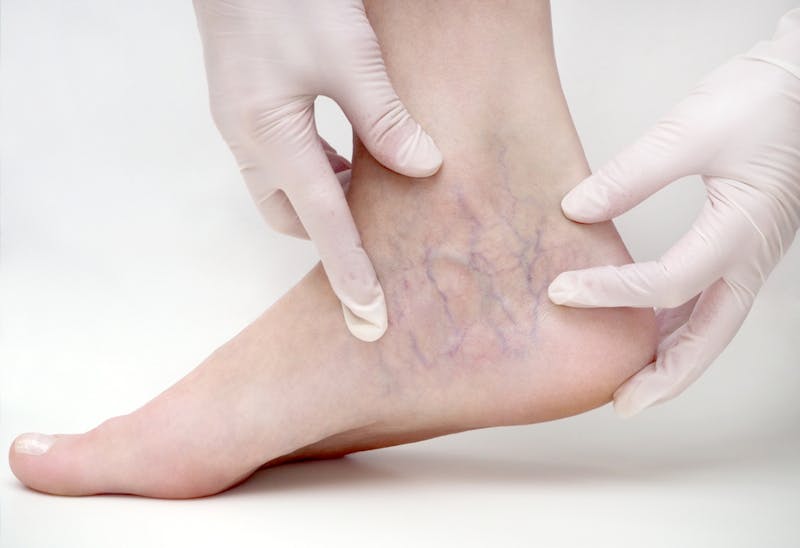What are the symptoms of vascular malformations?
Vascular malformations are abnormal formations of blood vessels that can occur anywhere in the body. The symptoms of vascular malformations depend on their type, location, and size. Here are some common symptoms associated with different types of vascular malformations:
- Port-Wine Stain (Capillary Malformation):
- Flat, pink or red birthmarks on the skin that can darken over time.
- Typically present at birth and do not fade.
- Hemangiomas:
- Red or purple raised lesions on the skin that may grow rapidly in infancy and then gradually shrink over time.
- May cause functional problems if they occur in sensitive areas like the eyes, mouth, or throat.
- Venous Malformations:
- Blue or purple discoloration of the skin due to dilated veins.
- Swelling or pain in the affected area.
- Possible development of varicose veins or enlarged veins.
- Arteriovenous Malformations (AVMs):
- Abnormal connections between arteries and veins that can cause symptoms such as:
- Lymphatic Malformations:
- Swelling in areas like the neck, armpits, or groin.
- Soft, cystic masses that may change in size.
- Fluid leakage or recurrent infections in the affected area.
- Klippel-Trénaunay Syndrome:
- Combination of symptoms including:
- Port-wine stains or capillary malformations.
- Varicose veins or venous malformations.
- Limb overgrowth or asymmetry.
Symptoms of vascular malformations can vary significantly based on their location and involvement of surrounding structures. In some cases, vascular malformations are asymptomatic and discovered incidentally, while in others, they can lead to significant health issues or complications. If a vascular malformation is suspected, evaluation by a healthcare provider, often with imaging studies like ultrasound, MRI, or CT scans, is necessary for accurate diagnosis and appropriate management.
What are the causes of vascular malformations?
Vascular malformations arise from abnormalities in the development of blood vessels. The causes can be diverse and are generally related to genetic, developmental, or environmental factors. Here’s a breakdown of potential causes:
- Genetic Factors:
- Some vascular malformations are linked to genetic mutations or inherited conditions. For instance:
- Hereditary Syndromes: Conditions like Klippel-Trénaunay syndrome, Sturge-Weber syndrome, and Cowden syndrome can be associated with vascular malformations.
- Genetic Mutations: Specific genetic mutations can affect vascular development and lead to conditions like hereditary hemorrhagic telangiectasia (HHT).
- Developmental Abnormalities:
- Vascular malformations often result from errors in blood vessel formation during embryonic development. These abnormalities can include:
- Improper Vessel Formation: Abnormal connections between arteries and veins (arteriovenous malformations), or malformed capillaries, veins, or lymphatic vessels.
- Disrupted Angiogenesis: Abnormal blood vessel growth or differentiation during fetal development.
- Environmental Factors:
- Some vascular malformations may be influenced by environmental factors, although specific causes are often less clear. Potential environmental influences include:
- Maternal Health: Certain conditions or exposures during pregnancy, such as infections or exposure to toxins, might impact vascular development.
- Pregnancy Complications: Complications like maternal diabetes or hypertension could potentially affect vascular formation.
- Idiopathic Causes:
- In many cases, the exact cause of a vascular malformation remains unknown, and these are termed idiopathic. The malformations arise without a clearly identifiable reason and can occur sporadically.
Overall, while some vascular malformations have a clear genetic or developmental basis, others may not have a well-defined cause. Diagnosis often involves imaging studies and genetic testing to understand the nature of the malformation and guide appropriate treatment.
What is the treatment for vascular malformations?
Treatment for vascular malformations depends on their type, location, size, and the symptoms they cause. The goal is to manage symptoms, prevent complications, and, in some cases, correct or reduce the malformation. Here’s an overview of common treatments for different types of vascular malformations:
- Observation and Monitoring: For some vascular malformations that are asymptomatic and not causing significant issues, a “watch and wait” approach may be recommended. Regular monitoring through imaging studies ensures that any changes or complications are detected early.
- Medications:
- Pain Management: Analgesics or anti-inflammatory medications may be used to manage pain or discomfort associated with the malformation.
- Hormonal Therapy: In some cases, hormonal treatments like interferon or propranolol may be used, particularly for hemangiomas or lymphatic malformations.
- Surgical Interventions:
- Excision: Surgical removal of the malformation may be indicated if it causes significant symptoms or complications. This is common for certain hemangiomas or venous malformations.
- Endovenous Laser Therapy (EVLT) or Sclerotherapy: These techniques involve inserting a catheter into the affected vein and using laser or chemical agents to close or shrink the malformed vessels. This is often used for varicose veins or venous malformations.
- Endovascular Procedures:
- Embolization: A minimally invasive procedure where a catheter is used to deliver materials (such as coils or particles) to block abnormal blood vessels, reducing blood flow to the malformation and decreasing its size. This is commonly used for arteriovenous malformations (AVMs) or large hemangiomas.
- Radiation Therapy:
- For Specific Types: Radiation therapy may be used to shrink certain vascular malformations, particularly in cases where other treatments are not effective or feasible. This is less common but can be considered for certain AVMs or hemangiomas.
- Supportive Care:
- Compression Therapy: For venous malformations or lymphatic malformations, compression garments or bandages can help manage swelling and improve symptoms.
- Physical Therapy: May be recommended to help with functional issues related to the malformation, especially if it affects mobility or daily activities.
- Genetic Counseling and Supportive Care:
- For Hereditary Syndromes: Individuals with genetic conditions associated with vascular malformations may benefit from genetic counseling and ongoing management for related health issues.
Treatment is often tailored to the individual, considering the type of malformation, its effects on the body, and the patient’s overall health. A multidisciplinary team, including specialists in dermatology, vascular surgery, interventional radiology, and genetic counseling, may be involved in managing vascular malformations.

Leave a Reply
You must be logged in to post a comment.